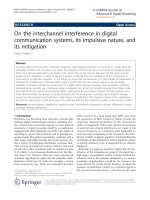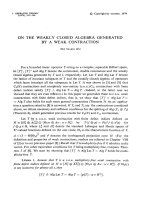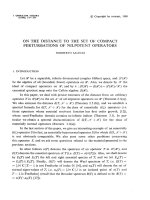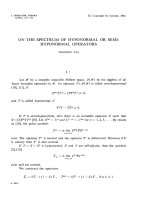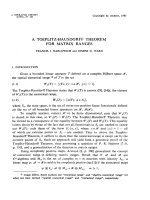Báo cáo toán học: "On the upper and lower chromatic numbers of BSQSs(16)" ppt
Bạn đang xem bản rút gọn của tài liệu. Xem và tải ngay bản đầy đủ của tài liệu tại đây (129.64 KB, 8 trang )
On the upper and lower chromatic numbers
of BSQSs(16)
∗
Giovanni Lo Faro
Department of Mathematics, University of Messina
Salita Sperone, 31 - 98166 Sant’Agata - Messina, Italy.
E-mail:
Lorenzo Milazzo
Department of Mathematics, University of Catania
Viale A. Doria, 6 95125 - Catania, Italy.
E-mail:
Antoinette Tripodi
Department of Mathematics, University of Messina
Salita Sperone, 31 - 98166 Sant’Agata - Messina, Italy.
E-mail:
Submitted: September 6, 1999; Accepted: October 20, 2000
Abstract
A mixed hypergraph is characterized by the fact that it possesses C-edges as
well as D-edges. In a colouring of a mixed hypergraph, every C-edge has at least
two vertices of the same colour and every D-edge has at least two vertices coloured
differently. The upper and lower chromatic numbers ¯χ, χ are the maximum and
minimum numbers of colours for which there exists a colouring using all the colours.
The concepts of mixed hypergraph, upper and lower chromatic numbers are applied
to SQSs. In fact a BSQS is an SQS where all the blocks are at the same time
C-edges and D-edges. In this paper we prove that any BSQS(16) is colourable
with the upper chromatic number ¯χ = 3 and we give new information about the
chromatic spectrum of BSQSs(16).
∗
Supported by cofin. MURST “Strutture geometriche, combinatorie e loro applicazioni” and by C.N.R.
(G.N.A.S.A.G.A.).
the electronic journal of combinatorics 8 (2001), #R6 1
1 Introduction
A mixed hypergraph [11, 12] is a triple H =(X, C, D), where X is a finite set of vertices,
while C and D are two families of subsets of X. The elements of C and D are called C-edges
and D-edges respectively. If C = ∅ then H is called a D-hypergraph, while if D = ∅ then
H is called a C-hypergraph.
A strict k-colouring of H is a vertex colouring where any C-edge has at least two vertices of
the same colour and any D-edge has at least two vertices coloured differently, and exactly
k colours are used in it. If it is not necessary to know the number of used colours then a
strict k-colouring will be called strict colouring.
The minimum (maximum) k for which there exists a strict k-colouring is called the lower
(upper) chromatic number of H and is denoted by χ (¯χ). If there exists no strict colouring
of H,thenH is said to be uncolourable.
Two strict colourings of H are different if there exist two vertices such that in one colouring
they have different colours and with the same colour in the other one. Let us denote r
k
as the number of different strict colourings of H using k colours; we will call the vector
R(H)=(0, 0, ,r
χ
, ,r
¯χ
, ,0, 0) the chromatic spectrum of H [12, 6].
The set L ⊆ X is called a C-stable set (D-stable set) if it does not contain any C-edges
(D-edges). If L does not contain C-edges and D-edges at the same time then it is called
a bi-stable set.
A D-hypergraph is a classical hypergraph [1] and its lower chromatic number is the chro-
matic number introduced by Erd˝os and Hajnal in 1966 [3].
In this paper the concepts of strict colouring and upper and lower chromatic numbers are
applied to a particular t-design called a Steiner quadruple system.
Briefly, by a t-design S
λ
(t, k, v)wemeanapair(X,B)whereX is a v-set of vertices and
B is a collection of k-element subsets of X, usually called blocks such that every t-element
subset of X occurs in exactly λ blocks of B.Whenλ =1thet-design is referred to as a
Steiner system S(t, k, v).
A Steiner Quadruple System (briefly SQS) is an S(3, 4,v). In 1960 Hanani [5] proved that
an SQS(v) exists if and only if v ≡ 2 or 4(mod6).
A BSQS is a Steiner Quadruple System where all the blocks are at the same time C-edges
and D-edges [8].
In [8, 9, 10] the necessary conditions for the existence of strict colourings for BSQSswere
determined and the exact value of the upper chromatic number for BSQS(8), BSQS(10)
was found in [9].
In [9] it was proved that for BSQSs(16) obtained by doubling construction ¯χ =3orthey
are uncolourable.
The aim of this paper is to prove that any BSQS(16) is colourable with ¯χ = 3 and we
will show that only two kinds of chromatic spectrum can exist for a BSTS(16).
the electronic journal of combinatorics 8 (2001), #R6 2
In the next section we will use the following theorem, proved in [4] for more general Steiner
systems than SQSs.
Theorem 1 In an SQS(v)(X,B), if H ⊆ X, |H| = h, T
H
is the set of blocks included
in H, and T
X−H
is the set of blocks included in X − H, then
1. f(v,h)=|T
H
|−|T
X−H
|, f(v,h)=b
0
−
v−h
1
= b
1
+
v−h
2
b
2
−
v−h
3
,
where b
i
=
v−i
3−i
/
4−i
3−i
for 0 ≤ i ≤ 2;
2. If d
H
(x)=|{b ∈ B : x ∈ b and b ⊆ H}| and
δ
H
(x)=|{b ∈ B : x ∈ b −{x} and b ⊆ X − H}|, then
d
H
(x)+δ
H
(x)=f(v,h) − f(v, h − 1).
2 Upper chromatic number of BSQS(16)
Let us assume that a BSQS is colourable with the strict colouring P which uses h colours,
the colouring class X
i
is the vertex set coloured with the colour (i)and|X
i
| = n
i
.It
is clear that P partitions the vertex set into a family of bi-stable sets. Let us consider
the class of strict k-colourings which partition the vertex set into k colouring classes with
cardinalities n
1
, n
2
, ···,n
k
. We will denote this class with the h-tuple (n
1
,n
2
, ···,n
h
)
where n
i
≤ n
i+1
for 1 ≤ i ≤ h. P colours the blocks of BSQS in three possible ways:
i) Three vertices are coloured with one colour and the other vertex is coloured with another
one;
ii) Two vertices are coloured with one colour and the other two vertices are coloured with
another one;
iii) Two vertices are coloured with one colour and the other two vertices are coloured
with two different colours different from the first.
If I ⊆{1, 2, ···,h},with|I|≥2, then let us define the set of vertices S
I
⊆ X as the
union of |I| colouring classes coloured with the colours (i) inside I. The number of triples
of vertices coloured with different colours of P in S
I
,if|S
I
| = s
I
,is:
c
I
=
s
I
3
−
j∈I
n
j
3
+
j∈I
n
j
2
(s
I
− n
j
)
,
the electronic journal of combinatorics 8 (2001), #R6 3
by the definitions of strict colouring and SQS we can give the following proposition.
Proposition 1 If P is a strict colouring for a BSQS which uses h colours, then
1)
h
i=1
n
i
3
blocks are coloured as in i);
2) ( c
I
/ 2)blocks are coloured as in iii), where I
= {1, 2, ···,h};
3) |B|−
c
I
2
−
h
i=1
n
i
3
blocks are coloured as in ii);
4) all the c
I
have to be even.
The following theorem proves that any BSQS(16) is uncolourable with four colours.
Theorem 2 If a BSQS(16) is colourable then ¯χ ≤ 3.
Proof.
In [9] it was proved that ¯χ ≤ 4 and if a BSQS(16) is colourable with four colours then it
is necessary to use one of the following strict colourings: p =(2, 4, 5, 5) or k =(2, 3, 5, 6).
We will prove that the colourings p and k are not strict colourings and ¯χ =3. Let
X = {1, 2, ,16} be the set of vertices of BSQS(16).
If p =(2, 4, 5, 5) is a strict colouring, by theorem 1 we have |T
X
1
∪X
2
∪X
3
| = 25. However,
the number of 3-chromatic blocks coloured with the colours (1), (2) and (3) is 20 and the
number of bi-chromatic blocks coloured with the colours (2) and (3) is at least 7 and so
|T
X
1
∪X
2
∪X
3
|≥27 and this is absurd.
Let us consider a strict colouring k =(2, 3, 5, 6).
We have |T
X
1
∪X
2
∪X
3
| = 15, so all the blocks of T
X
1
∪X
2
∪X
3
are 3-chromatic. It is important
to note that a monochromatic pair of vertices coloured with the colour (1), (2) and (3) is
present at least once in the blocks of T
X
1
∪X
2
∪X
3
, and precisely 13 of the 14 above-mentioned
monochromatic pairs are present exactly once while the remaining pair is present twice.
Let us define the colouring classes in this way: X
1
= {1, 2}, X
2
= {3, 4, 5}, X
3
=
{6, 7, 8, 9, 10} and X
4
= {11, 12, 13, 14, 15, 16}. All the blocks of T
X
1
∪X
2
∪X
3
contain the
{1} vertex or the {2} vertex; more precisely: seven blocks contain {1} and not {2}; seven
blocks contain {2} and not {1} and exactly one block contains the pair {1, 2}.Wemay
assume that {1, 2, 3, 6}∈T
X
1
∪X
2
∪X
3
and that the pair {3, 4} appears in a block containing
{1}, so without loss of generality we can share the blocks of T
X
1
∪X
2
∪X
3
in the following
way:
the electronic journal of combinatorics 8 (2001), #R6 4
{1, 2, 3, 6}{2, 3, 8, 9}
{1, 3, 4, 7}{2, 3, 7, 10}
{1, 3, 5, 8}{2, 4, 5, ·}
{1, 3, 9, 10}{2, 4, ·, ·}
{1, 4, 6, 9}{2, 4, ·, ·}
{1, 4, 8, 10}{2, 5, ·, ·}
{1, 5, 7, 9}{2, 5, ·, ·}
{1, 5, 6, 10}
Table 1
We cannot add the pairs {6, 7}, {6, 8} and {7, 8} inside the incomplete blocks of Table 1
without violating the definition of SQS.
The next theorem will prove that all BSQSs(16) are colourable with strict colourings
which use three colours. This theorem is important because it shows that uncolourable
BSQSs(16) do not exist.
Theorem 3 For any BSQS(16), ¯χ =3.
Proof.
Let (S, B)beaBSQS(16). It is not difficult to see that we can find a bi-stable set
N
1
with |N
1
| = 6. Let us assume N
1
= {1, 2, 3, 4, 5, 6}.IfH = {7, 8, 9, ,16} then
|T
H
|−|T
N
1
| =15andso|T
H
| = 15.
Let h
1
∈ H be such that d
H
(h
1
)=max{d
H
(h):h ∈ H} and let us assume h
1
=7. By2.
of theorem 1 we have d
H
(7) = 6 + x,with0≤ x ≤ 2. If H
= H −{7} then |T
H
| =9− x.
Let h
2
∈ H
such that d
H
(h
2
)=max{d
H
(h): h ∈ H
} and suppose h
2
=8. Wehave
d
H
(8) ≥
4(9−x)
9
=4−
4
9
x.Letd
H
(8) = 4 + y. The pair {7, 8} is obviously contained in
at least one block of T
H
and so 0 ≤ y ≤ 3. Let us denote with B
the set of blocks b of
T
H
such that b ∩{7, 8} = ∅, obviously |B
| =5− (x + y). Let us consider the following
cases.
Case 1: x + y = 5. The sets of vertices N
1
, {7, 8}, {9, 10, ,16} give a strict colouring
for BSQS(16).
Case 2: x + y =4. Ifb = {9, 10, 11, 12} is the only block of B
,thenN
1
, {7, 8, 9},
{10, 11, ,16} give a strict colouring for BSQS(16).
Case 3: x + y =3. Letb
1
, b
2
be the blocks of B
.Ifb
1
∩ b
2
= ∅, then we can assume
that b
1
= {9, 10, 11, 12} and b
2
= {13, 14, 15, 16}.Let{7, 8, 9,k}∈B, then it is possible
the electronic journal of combinatorics 8 (2001), #R6 5
to find t ∈ b
2
, t = k, such that N
1
, {7, 8, 9,t}, {10, 11, ,16}−{t} give a strict colouring
for BSQS(16).
Case 4: x + y =2. LetB
= {b
1
,b
2
,b
3
}. We can assume that there exists an element,
let us say 9, such that 9 ∈ b
1
∩ b
2
.If9∈ b
3
then N
1
, {7, 8, 9} and {10, 11, ,16} give
a strict colouring for BSQS(16); otherwise, let b
3
= {10, 11, 12, 13} and {7, 8, 9,k}∈B,
then it is possible to find t ∈ b
3
, t = k, such that N
1
, {7, 8, 9,t}, {10, 11, ,16}−{t}
give a strict colouring for BSQS(16).
Case 5: x + y =1. LetB
= {b
1
,b
2
,b
3
,b
4
}.Ifb
1
∩ b
2
∩ b
3
∩ b
4
= ∅ (let us assume
9 ∈ b
1
∩b
2
∩b
3
∩b
4
)thenN
1
, {7, 8, 9}, {10, 11, ,16} give a strict colouring for BSQS(16).
If b
1
∩ b
2
∩ b
3
∩ b
4
= ∅, then we have two possibilities.
i) There are three blocks of B
,letussayb
1
, b
2
, b
3
, such that b
1
∩ b
2
∩ b
3
= ∅.Wecan
assume that 9 ∈ b
1
∩ b
2
∩ b
3
b
4
= {10, 11, 12, 13}.If{7, 8, 9,k}∈B, then it is possible to
find t ∈ b
4
, t = k, such that N
1
, {7, 8, 9,t}, {10, 11, ,16}−{t} give a strict colouring
for BSQS(16).
ii) For every z ∈{9, 10, ,16} there are exactly two blocks of B
containing z.Thenwe
can assume that
b
1
= {9, ·, ·, ·},b
2
= {9, ·, ·, ·}
b
3
= {10, ·, ·, ·},b
4
= {10, ·, ·, ·}
If {7, 8, 9, 10} /∈B,thenN
1
, {7, 8, 9, 10}, {11, 12, ,16} give a strict colouring for
BSQS(16). Let {7, 8, 9, 10}∈B, we can assume, without loss of generality, that
b
3
= {10, 11, 12, 13}
b
4
= {10, 14, 15, 16}
and so,
b
1
= {9, 11, 12, 14}
b
2
= {9, 13, 15, 16}.
If {7, 8, 11, 15} /∈B,thenN
1
, {7, 8, 11, 15}, {9, 10, 12, 13, 14, 16} give a strict colouring
for BSQS(16); otherwise N
1
, {7, 8, 11, 16}, {9, 10, 12, 13, 14, 15} give a strict colouring for
BSQS(16).
Case 6: x + y = 0. From the hypothesis on d
7
and d
8
we have:
1. d
z
=6,for∀z ∈ H;
the electronic journal of combinatorics 8 (2001), #R6 6
2. any pair of distinct elements of H is contained exactly in two blocks of T
H
.
So T
H
is one of the three nonisomorphic S
2
(2, 4, 10) designs [7].
I II III
{7, 8, 9, 10}{7, 8, 9, 10}{7, 8, 9, 10}
{7, 8, 11, 12}{7, 8, 11, 12}{7, 8, 11, 12}
{7, 9, 11, 13}{7, 9, 11, 13}{7, 9, 13, 14}
{7, 10, 14, 15}{7, 10, 14, 15}{7, 10, 15, 16}
{7, 12, 14, 16}{7, 12, 14, 15}{7, 11, 13, 15}
{7, 13, 15, 16}{7, 13, 15, 16}{7, 12, 14, 16}
{8, 9, 14, 15}{8, 9, 14, 16}{8, 9, 15, 16}
{8, 10, 13, 16}{8, 10, 11, 16}{8, 10, 13, 14}
{8, 11, 14, 16}{8, 11, 14, 15}{8, 11, 14, 16}
{8, 12, 13, 15}{8, 12, 13, 15}{8, 12, 13, 15}
{9, 10, 12, 16}{9, 10, 12, 15}{9, 10, 11, 12}
{9, 11, 15, 16}{9, 11, 15, 16}{9, 11, 14, 15}
{9, 12, 13, 14}{9, 12, 13, 14}{9, 12, 13, 16}
{10, 11, 12, 15}{10, 11, 12, 16}{10, 11, 13, 16}
{10, 11, 13, 14}{10, 11, 13, 14}{10, 12, 14, 15}
In any case N
1
, {7, 8, 9, 11, 14}, {10, 12, 13, 15, 16} give a strict colouring for these
BSQSs(16).
In [2] it is shown that it is possible to construct BSQSs(16) which contain blocking sets
and BSQSs(16) which do not contain any blocking set. So BSQSs(16) colourable with
strict colourings which use two and three colours exist and only “3-strict” colourable
BSQSs(16) also exist.
There are two classes of BSQS(16): the first class contains BSQSs(16) with χ =¯χ =3;
the second one contains BSQSs(16) with χ = 2 or ¯χ =3.
The next theorem completes theorem 3 and gives important information about the chro-
matic spectrum of BSQSs(16).
Theorem 4 The upper chromatic number for all BSQSs(16)is¯χ =3; the lower chro-
matic number for a BSQS(16)canbeχ =3or χ =2.
the electronic journal of combinatorics 8 (2001), #R6 7
References
[1] C. Berge: Hypergraphs: combinatories of finite sets. North Holland, (1989).
[2] J. Doyen, M. Vandersavel: Non isomorphic Steiner quadruple systems. Bullettin
de la Soci´et´eMath´ematique de Belgique 13, (1971), 393–410.
[3] P. Erd
˝
os, A. Hajnal: On chromatic number of graphs and set-systems. Acta Math.
Acad. Sci. Hung. 17, (1966), 61–99.
[4] M. Gionfriddo, G. Lo Faro: 2-colourings in S(t, t +1,v). Discrete Math. 111,
(1993), 263–268.
[5] H. Hanani: On quadruple systems. Canadian Journal Mathematics 12, (1960).
[6] T. Jiang, D. Mubayi, Zs. Tuza, V. Voloshin, D. West: The chromatic spec-
trum is broken. 6th Twente Workshop on Graphs and Combinatorial Optimization, 26-
28 May, 1999, H.J. Broersma, U. Faigle and J.L. Hurink (eds.).University of Twente,
May, 1999, 231–234.
[7] R. Mathon, A. Rosa: 2 − (v, k, λ) designs of small order. The CRC handbook of
combinatorial designs , Ed. J. Colburn, J. Dinitz, CRC, (1996), 3–41.
[8] L. Milazzo, Zs. Tuza: Upper chromatic number of Steiner triple and quadruple
systems. Discrete Math. 174 (1997), 247–259.
[9] L. Milazzo: On upper chromatic number for SQS(10) and SQS(16). Le Matamatiche
(1995), L, 179–193.
[10] L. Milazzo: Sul numero cromatico superiore nei sistemi di Steiner. PhD Thesis,
University of Catania, (1996).
[11] V. I. Voloshin: The mixed hypergraph. Comput. J. Moldova 1 (1993), 45–52.
[12] V. I. Voloshin: On the upper chromatic number of a hypergraph. Australasian J.
Combin. 11 (1995), 25–45.
the electronic journal of combinatorics 8 (2001), #R6 8


